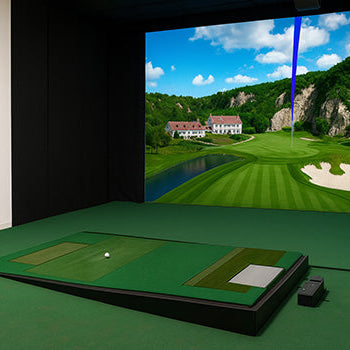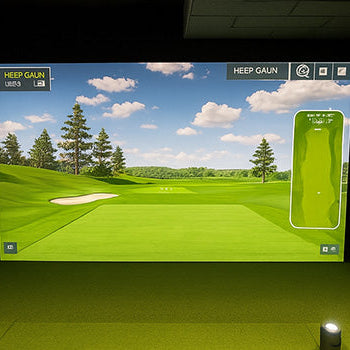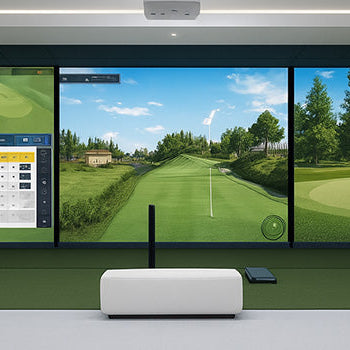Tired of sending dented range balls, and maybe a lamp, flying through your lounge? A Golf Simulator setup keeps your swing sharp and your drywall intact. Short answer: you’ll need a launch monitor, hitting mat, impact screen + enclosure, short-throw projector, and reliable software. Stick around for pro tips, budget hacks, and add-ons that turn any spare room into Pebble Beach.

The Core Components: The Non-Negotiables
Your simulator lives or dies by these five pieces of kit. Skip one and you’ll feel it every swing. You can find them all in our Golf Simulator Collection.
The Launch Monitor: The Heart of Your Simulator
No piece of tech matters more. It tracks your swing, crunches the numbers, and tells you, bluntly, why the ball just duck-hooked.
Key Differences: Radar vs. Photometric (Camera-Based)
Radar systems use Doppler waves to track ball flight, ideal for larger rooms or outdoor setups.
Photometric systems rely on high-speed cameras to capture detailed data, perfect for compact indoor spaces where precision matters.
Essential Data Points to Look For
Must-haves: ball speed, launch angle, spin rate, carry distance, club-head speed and path.
Extra metrics are nice, but miss these and you’re guessing, not improving.
The Hitting Mat: The Foundation of Your Setup
Your wrists and clubs meet the mat first, treat them kindly.
Why a Quality Mat Prevents Injury and Improves Realism
Cheap, thin turf can jar joints and groove bad habits. Look for dense, shock-absorbing turf with a rubber base so fat shots feel fat and pure strikes feel pure.
The Impact Screen & Enclosure: Safety and Visuals
Miss here and your nine-iron could break a family heirloom.
Choosing the Right Size and Material
Heavy-duty polyester or specialized projection fabric shrugs off 180 mph wedges and still looks crisp. Most home setups do fine with 10 × 10 ft; larger rooms can stretch to 16 × 9 ft. Add side netting so the odd shank stays in-bounds.
The Projector: Bringing the Course to Life
No projector, no Augusta, just a white sheet.
Lumens, Resolution, and Throw Ratio Explained
-
Lumens: 3,000–4,000 keeps the fairway bright even with lights on.
-
Resolution: 1080p looks great; 4K looks incredible.
-
Throw ratio: Short-throw (< 4 ft) eliminates shadows in small rooms.
The Brains of the Operation: Software and Computing
Great hardware needs smart software, or you’re stuck on a pixelated driving range.
Golf Simulator Software: Choosing Your Virtual Courses
One leading software option offers high-end graphics and online tournament play.
Another features thousands of user-created courses to keep things fresh.
A third stands out for its incredible realism and detailed replicas of real-world golf courses.
Pick the one with the courses, and multiplayer options, you’ll actually use. You’ll find compatible systems in our Golf Simulator range.
PC Requirements: Ensuring a Smooth Experience
Bare minimum: Intel i5 / Ryzen 5, 16 GB RAM, GTX 1660 or better, 256 GB SSD. Stable internet and surge protection keep hiccups away.
iPad and Tablet Compatibility
Some launch monitors run on iPad or Android. Handy for quick setups, but graphics dip and frame rates drop, fine for casual play, thin for data-driven practice.

Optional but Recommended Upgrades
These extras don’t make the simulator work, they make it wonderful.
Stance and Alignment Aids
Laser lines, stance mats, or simple alignment sticks keep your feet honest. Small tweak, huge consistency boost.
Ball Trays and Club Racks
Automatic ball-return trays speed up practice; tidy club racks stop shafts clattering in the corner. A neat bay feels like a tour studio, not a garage.
Camera Systems for Swing Analysis
High-speed cameras let you freeze every frame of your takeaway, and fix that funky elbow. Pricey, yes, but nothing beats video for proof.
Putting It All Together: All-in-One Packages vs. DIY Builds
Two roads: unpack and play, or build and tinker.
The Pros and Cons of Pre-Built Simulator Packages
Pros: zero guesswork, matched components, tech support on speed-dial.
Cons: higher price, limited customisation. Perfect if you want fast, fool-proof fun. Explore ready-made bundles in our Golf Simulator Collection to get started instantly.
Building Your Own Simulator: A Step-by-Step Component Guide
Pick a launch monitor that fits your room.
Lay a shock-absorbing mat.
Hang an impact screen and wrap it with netting.
Mount a short-throw projector.
Install software on a gaming-ready PC.
Add accessories, when budget allows, for a personal touch. DIY saves cash and lets you upgrade at will.

Where to Buy Your Golf Simulator Components
Specialist golf retailers often offer bundled simulator setups with trusted components.
Official manufacturer websites typically sell direct and include warranty support and product-specific guidance.
Amazon & eBay work for mats, nets, and accessories, just check reviews and return policies.
Or simplify it all with our hand-picked Golf Simulator products, tailored for home performance and total playability.








